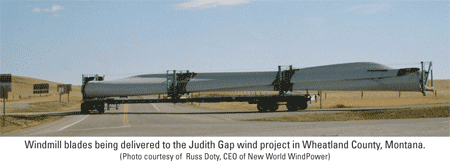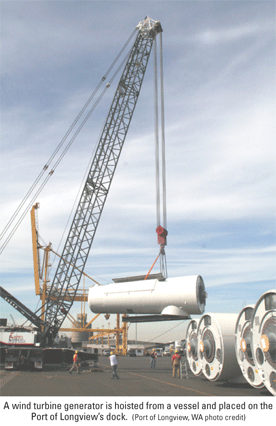 By Leo Quigley, AJOT
By Leo Quigley, AJOTWind once moved the world’s cargo ships. Today, cargo ships move equipment to catch the wind and generate energy to support America’s energy-dependant way of life.
At present, wind provides enough power to supply three million American households and the rush is on to provide much more. However, the task of transporting the tall, fragile wind turbines with blades that reach over 100 feet in length to the breeziest fields and hilltops in America is a daunting task.
To a large extent, the components arrive by ship and, at some ports, the awkward packages that require considerable storage space can be a nuisance. However, to others, they are proving to be a lucrative market niche.
According to information provided by the Washington-based American Wind Energy Association (AWEA), the state with the most wind energy installed is Texas (2,768 MW), followed closely by California (2,361 MW), Iowa (936 MW), Minnesota (895 MW) and Washington (818 MW).
The largest wind farm in the country, by far, is Horse Hollow, Texas, that generates 736 MW, followed by Maple Ridge, New York (322 MW) and Stateline, Oregon/Washington (300 MW).
The turbines, that can stand 330 to 490 feet tall, have increasingly become more powerful. Last year’s turbines averaged 1.6 MW in rated capacity, which is more than twice the capacity of the average wind turbine installed in 2000.
Christine Real de Azua, spokesperson for the AWEA, said membership in their organization, representing stakeholders throughout the industry, including transportation companies, has grown from roughly 200 business members in 2000 to over 1,000 companies this year.
“The demand for wind turbines is so strong that we’re seeing both imports and investments in manufacturing to build up the supply chain here in the US,” Real de Azua said. “Chances are that a wind turbine going up is going to have parts that have come both from the US and from overseas.”

Siemens Wind Power, a division of Siemens AG, the international supplier of engineering expertise for automation and controls, information, communications, lighting, medical, power, transportation and water technologies, is one of several major corporations involved in America’s wind power industry.
Clare Bertel, Wind Transportation Coordinator with Siemens Wind Power, Orlando, Florida, told AJOT that the company builds and supplies all components for several models of wind turbines and recently purchased a wind tower blade factory in Fort Madison, Iowa, which will be coming on stream this fall.
In addition, the company has contracted with the Port of Longview to handle wind tower components for several wind energy projects in the US Pacific Northwest this year. Among these projects is the Klondike III Wind Farm located in Sherman County, Oregon.
Turbine components for the 44-tower farm are manufactured by Siemens in Denmark and include 148-foot fiberglass blades, 87-ton nacelles (generators), hubs, spinners, power units and containers filled with hardware.
The offloading system used by the Port of Longview has been custom designed by the port based on designs supplied by Siemens. As well, the Port of Longview has secured nine additional acres to provide storage for windmill components, has purchased several pieces of specialized equipment to handle the components, and is planning to purchase a mobile crane to further facilitate the unloading of this highly specialized breakbulk cargo.
Special handlingMoving the fiberglass windmill blades requires special handling both at the docks and on the highway.
“We use an extendible flatbed truck,” Bertel said. “By the time the blade is put on it, it hangs 20 feet beyond the back and is almost 200 fee

 Siemens Wind Power, a division of Siemens AG, the international supplier of engineering expertise for automation and controls, information, communications, lighting, medical, power, transportation and water technologies, is one of several major corporations involved in America’s wind power industry.
Clare Bertel, Wind Transportation Coordinator with Siemens Wind Power, Orlando, Florida, told AJOT that the company builds and supplies all components for several models of wind turbines and recently purchased a wind tower blade factory in Fort Madison, Iowa, which will be coming on stream this fall.
In addition, the company has contracted with the Port of Longview to handle wind tower components for several wind energy projects in the US Pacific Northwest this year. Among these projects is the Klondike III Wind Farm located in Sherman County, Oregon.
Turbine components for the 44-tower farm are manufactured by Siemens in Denmark and include 148-foot fiberglass blades, 87-ton nacelles (generators), hubs, spinners, power units and containers filled with hardware.
The offloading system used by the Port of Longview has been custom designed by the port based on designs supplied by Siemens. As well, the Port of Longview has secured nine additional acres to provide storage for windmill components, has purchased several pieces of specialized equipment to handle the components, and is planning to purchase a mobile crane to further facilitate the unloading of this highly specialized breakbulk cargo.
Special handlingMoving the fiberglass windmill blades requires special handling both at the docks and on the highway.
“We use an extendible flatbed truck,” Bertel said. “By the time the blade is put on it, it hangs 20 feet beyond the back and is almost 200 fee
Siemens Wind Power, a division of Siemens AG, the international supplier of engineering expertise for automation and controls, information, communications, lighting, medical, power, transportation and water technologies, is one of several major corporations involved in America’s wind power industry.
Clare Bertel, Wind Transportation Coordinator with Siemens Wind Power, Orlando, Florida, told AJOT that the company builds and supplies all components for several models of wind turbines and recently purchased a wind tower blade factory in Fort Madison, Iowa, which will be coming on stream this fall.
In addition, the company has contracted with the Port of Longview to handle wind tower components for several wind energy projects in the US Pacific Northwest this year. Among these projects is the Klondike III Wind Farm located in Sherman County, Oregon.
Turbine components for the 44-tower farm are manufactured by Siemens in Denmark and include 148-foot fiberglass blades, 87-ton nacelles (generators), hubs, spinners, power units and containers filled with hardware.
The offloading system used by the Port of Longview has been custom designed by the port based on designs supplied by Siemens. As well, the Port of Longview has secured nine additional acres to provide storage for windmill components, has purchased several pieces of specialized equipment to handle the components, and is planning to purchase a mobile crane to further facilitate the unloading of this highly specialized breakbulk cargo.
Special handlingMoving the fiberglass windmill blades requires special handling both at the docks and on the highway.
“We use an extendible flatbed truck,” Bertel said. “By the time the blade is put on it, it hangs 20 feet beyond the back and is almost 200 fee




